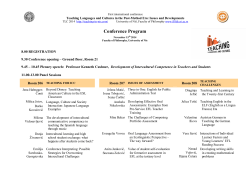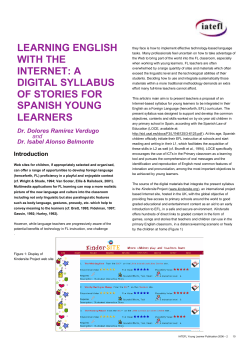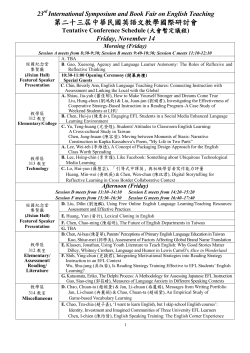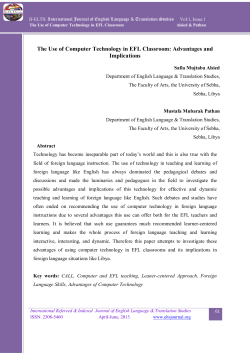
Document 317347
International Journal of Language Learning and Applied Linguistics World (IJLLALW) Volume 7 (2), October 2014; 50-‐57 Zareian, Gh., et al EISSN: 2289-‐2737 & ISSN: 2289-‐3245 www.ijllalw.org EFL LEARNERS' ATTITUDES TOWARDS ENGLISH LANGUAGE LEARNING: A FOCUS ON MALE AND FEMALES' PRIORITIES AND PREFERENCES Gholamreza Zareian (g.zareian@hsu.ac.ir) Department of English language and Literature, Hakim Sabzevari University, Sabzevar, Iran Ali Zangoei (zangoei.ali@gmail.com) English Department, University of Sistan and Baluchestan, Zahedan, Iran Mohammad Taghvaee (taghvaee2010@gmail.com) English Department, Imam Khomeini University of Naval Forces, Nowshahr, Iran ABSTRACT Attitudes toward English learning vary among learners of English as Foreign Language (EFL). The present study was conducted in Gonabad, Iran aiming at investigating high school EFL students' attitudes toward English learning using "The Beliefs about Language Learning Questionnaire" adopted from Sage (2011). Therefore, a sample including 123 male (N=69) and female (N=54) high school EFL students was selected. Also, a comparison was done using independent samples t-test and means of both genders in the above-mentioned questionnaire were compared. Data analysis indicated these participants' positive attitudes toward English learning (M=224.07). The results obtained from t-test indicated lack of any statistically significant difference between two genders (p>.05). The data analysis, also, confirmed that there existed a statistically significant difference between males and females in Interlanguage and individual variation (two components of the questionnaire) in favor of males. EFL teachers need to be aware of their students' attitudes toward English learning and do attempts to enhance their positive attitudes. KEYWORDS: EFL Learners, Attitudes toward English Learning, Gender INTRODUCTION Different learners in the context of English as Foreign Language (EFL) appear to have different attitudes toward language learning process. For example some of them learn English as a tool of communication in the new era in which interpersonal communications and interactions occur on the net among a great number of computer users who have access to the Internet and have already created an account in social networks. It seems profitable to be aware of EFL learners' attitudes toward English learning. Lin and Warden (1998) in their study investigating students’ perspectives about English learning stated that a better understanding of language learners can have positive effects on the process of attempting to help language learners in learning English as a foreign language. Fakeye (2010) views learner’s attitude as one of the most important factors 50 International Journal of Language Learning and Applied Linguistics World (IJLLALW) Volume 7 (2), October 2014; 50-‐57 Zareian, Gh., et al EISSN: 2289-‐2737 & ISSN: 2289-‐3245 www.ijllalw.org that impact on learning language. ESL/EFL learner's attitudes toward language learning have effect on his/her motivation in language learning (Al-Tamimi,& Shuib, 2009). Accordingly, Gardner and Lambert (1972) state that “his [the learner] motivation to learn is thought to be determined by his attitudes towards the other group in particular and by his orientation towards the learning task itself”(p.3). Additionally, Lifrieri (2005) states that “attitudes are necessary but insufficient indirect conditions for linguistic attainment" (p.14). Bernat and Lloyd (2007) state that researchers investigate how such attitudes vary from learner to learner, specifically regarding such individual differences as gender, age, nationality, learning style, and personality type. The present study aims to scrutinize EFL learners' attitude toward English learning as well as to do a comparison between males and females' attitudes toward Language learning. LITERATURE REVIEW Al-Tamimi and Shuib (2009) conducted a study in which they probed motivation and attitudes towards learning English. To gather their required data, Al-Tamimi and Shuib (2009) employed a questionnaire and interviews. Regarding the participants’ motivation, the findings indicated their greater support of instrumental reasons for learning the English language such as utilitarian and academic reasons. Personal reasons were also considered as important motives by them. Regarding their attitudes, it was found that most of students had positive beliefs on the social value and educational status of English. Additionally, the findings were indicative of the participants' positive orientation toward the English language. Interestingly enough, the findings showed that a great number of the students showed their interest in familiarity with the culture of the English speaking world as represented by English-language films (Al-Tamimi & Shuib, 2009). Sage (2011) in an article entitled " Learner Beliefs in South Korea: Enriching the Description" extracted attitudes toward Second Language Acquisition from 36 learners. Data analysis indicated harmful attitudes toward the ideal type of input and the usefulness of peer-to-peer interaction as well as beliefs which seem incompatible with interlanguage theory. More neutral attitudes regarding the effect of anxiety on language learning and the role of context in anxiety were also revealed (Sage, 2011). Bernat and Lloyd (2007) investigated the relationship between beliefs regarding language learning and gender. Their findings indicated that overall males and females had similar beliefs regarding language aptitude, the difficulty they perceive when learning a language, the nature of language learning, strategies in learning and communication, and their motivations and expectations. Males and females appear to be significantly different in their belief that multilinguals are very intelligent, with more females agreeing with that statement (Bernat & Lloyd, 2007). Zainol Abidin, Pour-Mohammadi, and Alzwari (2012) probed Libyan secondary school students’ attitudes towards learning English regarding the behavioral, cognitive and emotional dimensions. Regarding the three aspects of attitude including cognitive, behavioral, and emotional, the participants indicated negative attitudes towards learning English. Concerning the 51 International Journal of Language Learning and Applied Linguistics World (IJLLALW) Volume 7 (2), October 2014; 50-‐57 Zareian, Gh., et al EISSN: 2289-‐2737 & ISSN: 2289-‐3245 www.ijllalw.org differences in the participants’ attitude towards English by gender variable, it was found that the female secondary school students' attitudes towards English are slightly higher than that of male ones. Soleimani and Hanafi (2013) examined Iranian medical students' attitudes towards English language learning. Their findings suggested that the mean score of male students in attitude was higher than their female counterparts. Also, it was suggested that Iranian medical students had highly positive overall attitude regarding English language learning (Soleimani & Hanafi, 2013). RESEARCH QUESTIONS The following research question was posed by the researcher to be addressed in the present comparative study: 1. What are EFL learners' attitudes toward language learning? 2. Is there any statistically significant difference between EFL learners' attitudes toward language learning with respect to their gender, both as a composite score and in each of components of the construct? Research null-hypothesis Accordingly, to achieve the required data, the following research null-hypothesis was proposed to be statistically tested: 1. There is not any statistically significant difference between EFL learners' attitudes toward language learning with respect to their gender. METHODOLOGY Participants and Setting A sample population (N=123) of EFL learners studying in two model high schools of Gonabad, Iran (one female; one male) were selected based on Krejcie-Morgan table (1970) out of 180 students. Due to segregation rules in Iranian schools, one male as well as one female high school were selected. The students of these schools are accepted following the administration of an entrance examination. Participants' age ranged from 15 to 18. Farsi was their native language, and none of them had experienced studying or living in English speaking countries. Table 1: Descriptives of participants gender Valid female male Total Frequency Percent Valid Percent 54 69 123 43.9 56.1 100.0 43.9 56.1 100.0 Cumulative Percent 43.9 100.0 As Table 1 displays, 54 female students (43.9%) and 69male students (56.1%) participated in the present study. 52 International Journal of Language Learning and Applied Linguistics World (IJLLALW) Volume 7 (2), October 2014; 50-‐57 Zareian, Gh., et al EISSN: 2289-‐2737 & ISSN: 2289-‐3245 www.ijllalw.org Instrumentation To gather required data regarding EFL learners' attitudes towards English learning, "The Beliefs about Language Learning Questionnaire" adopted from Sage (2011), with some changes, was administered. The questionnaire consisted of 69 multiple-choice items based on a five-point Likert Scale ranging from "Strongly Agree" to "Strongly Disagree". In order to avoid any misunderstanding during the questionnaire completion by the participants, it was translated to Farsi. The items were scored based on the participants' gender. To make sure of the questionnaire reliability, it was piloted with a similar group of EFL learners in Gonabad high schools (α=.71) Procedure Students of two model high schools (N=123, Female=54; Male=69) in Gonabad, Iran were selected based on Krejcie-Morgan table (1970). They were from one female and one male model high schools. They were informed of the objectives of the study and were told to pay close attention while completing the questionnaire. They were assured that their identifying information will be anonymous. Next, every participant was given a Farsi copy of "The Beliefs about Language Learning Questionnaire" adopted from Sage (2011). The researcher was present during the questionnaire administration. Finally, having collected the required data, data analysis was conducted employing SPSS (19). RESULTS AND DISCUSSION Reliability of the Questionnaire To make sure that the instrument is reliable, Cronbach's Alpha was calculated employing SPSS (Table 2). Cronbach's Alpha .71 Table 2: Results of Reliability Statistics N of Items 69 As Table 2 shows, the questionnaire enjoys a relatively high index of reliability (α=.71). The First Research Question RQ1: What are EFL learners' attitudes toward language learning? To address the first research question, the participants' mean score was calculated. Data are shown in Table 3. Total N 123 Table 3: Results of participants' performance in questionnaire Mean Std. Deviation Std. Error Mean 224.07 13.489 1.216 As Table 3 shows, mean of the total number of the participants is 224.07 (SD=13.489). Table 3 indicates participants' positive attitudes toward English learning (M=224.07). In other words, participants have almost achieved 2/3 of the total score (345). 53 International Journal of Language Learning and Applied Linguistics World (IJLLALW) Volume 7 (2), October 2014; 50-‐57 Zareian, Gh., et al EISSN: 2289-‐2737 & ISSN: 2289-‐3245 www.ijllalw.org The Second Research Question To address the second research question independent samples t-test was conducted. Accordingly, two groups were formed based on gender (male vs. female). Table 4 displays relevant data. Group Male Female Table 4: Results of independent samples t-test for beliefs about English learning N M SD df t sig 69 225.51 13.38 121 1.34 .181 54 222.22 13.51 As Table 4 shows, there is not any statistically significant (df=121, t=1.34, sig=.181>.05) between males (N=69, M=225.51, SD=13.38) and females (N=54, M=222.22, SD=13.51) regarding their beliefs about English learning. Accordingly the null-hypothesis proposed by the researcher indicating that "There is not any statistically significant difference between EFL learners' attitudes toward language learning with respect to their gender" is accepted. Table 4 indicates that mean of males is slightly higher than females', but, the difference is not significant on the statistical basis. Concerning the components of the "Beliefs about Language Learning Questionnaire" independent samples t-test was again conducted. Results are displayed in Tables 5 and 6. Table 5: Results of group statistics for both genders Group Statistics Gender N Mean female 54 46.61 male 69 45.44 INTER female 54 17.83 male 69 18.72 IND female 54 55.64 male 69 58.28 INP female 54 40.07 male 69 40.37 MET female 54 57.77 male 69 58.55 * Note: AFF stands for Affective variables; INTER stands for Interlanguage; IND stands INP stands for Input and Output; MET stands for Methods of Learning AFF SD 4.93 3.35 2.26 2.46 3.22 4.29 4.58 3.92 6.40 4.91 for Individual variation; As Table 5 shows, means of females in AFF, INTER, IND, INP, and MET are 46.61, 17.83, 55.64, 40.07, and 57.77 respectively. Those of males are 45.44, 18.72, 58.28, 40.37, and 58.55, respectively. Table 6 shows results of independent samples t-test. 54 International Journal of Language Learning and Applied Linguistics World (IJLLALW) Volume 7 (2), October 2014; 50-‐57 Zareian, Gh., et al EISSN: 2289-‐2737 & ISSN: 2289-‐3245 www.ijllalw.org Table 6: Results of independent samples t-test for both genders Levene's Test for t-test for Equality of Means Equality of Variances AFF INTE R IND INP MET Equal variances assumed Equal variances not assumed Equal variances assumed Equal variances not assumed Equal variances assumed Equal variances not assumed Equal variances assumed Equal variances not assumed Equal variances assumed Equal variances not assumed F Sig. t df Sig. (2tailed) Mean Difference 10.688 .001 1.551 121 .124 1.16 1.482 89.11 .142 1.16 -2.06 121 .041 -.89 -2.08 117.9 .039 -.89 -3.76 121 .000 -2.64 -3.89 120.8 11 121 .000 -2.64 .694 -.30 .700 -.30 -.75 104.4 23 121 .450 -.77 -.733 96.96 .465 -.77 .447 6.202 .890 .505 .014 .347 -.394 -.38 .582 .447 According to data in Table 6, there is a significant difference (t=2.06, sig=.041<.05) between males (M=18.72, SD=2.46) and females (M=17.83, SD=2.26) in interlanguage component of Learner Beliefs, in favor of males. Also, data confirm the existence of a statistically significant difference (t=3.76, sig=.000) between males (M=58.28, SD=4.29) and females (M=55.64, SD=3.22) in individual variation in favor of males. Other components were not statistically and significantly different with respect to gender. Discussion The major purpose of the present study was to investigate Iranian high school EFL students' attitudes towards English learning as well as to do a comparison with respect to their gender. Two research questions were posed and addressed. The first research asked about Iranian high school EFL students' attitudes towards English learning. Data analysis indicated a relatively high mean for the total number of the participants (M=224.07). It can be concluded that the participants held positive attitudes toward learning English as their foreign language, regardless of their gender. The finding lent support to what Al-Tamimi and Shuib had found (2009) indicating the participants' positive orientation toward the English language learning. Also, Soleimani and Hanafi (2013) found that Iranian medical students had highly positive overall attitude to English language learning. To address the second research question, one null-hypothesis was proposed which indicated that "There is not any statistically significant difference between EFL learners' attitudes toward 55 International Journal of Language Learning and Applied Linguistics World (IJLLALW) Volume 7 (2), October 2014; 50-‐57 Zareian, Gh., et al EISSN: 2289-‐2737 & ISSN: 2289-‐3245 www.ijllalw.org language learning with respect to their gender". Independent samples t-test was employed to compare the means obtained by males and females. It was found that there was not any significant difference between their means. As a result, the null-hypothesis was accepted. Such similar beliefs on English learning between the two genders can be due to the participants' context sameness where they have studied English and developed similar background knowledge. This finding is in disagreement with Zainol Abidin et al.'s (2012) who concluded that female secondary school students' attitudes towards English are slightly higher compared to their male counterparts. On the contrary, Soleimani and Hanafi (2013) found that the mean score of male students in attitude was higher than their female counterparts. Moreover, data indicated statistically significant differences between males and females in two components of the questionnaire, e.g. interlanguage and individual variation (p<.05) in favor of amels. Other components did not significantly differ with respect to gender (p>.05). CONCLUSION The main purpose of the study was to investigate Iranian high school EFL students' attitudes towards English learning as well as to do a comparison with respect to their gender. The results revealed the learners' positive attitudes toward learning English without any significant difference between the two genders. However, there was a significant difference between males and females regarding Interlanguage and individual variation in favor of males. EFL teachers need to be aware of their students' attitudes toward English language learning to facilitate their learning process through adopting appropriate teaching methods and meeting their needs. Hopefully, further research will be conducted in the future to investigate EFL learners' other demographic factors including age, learning experience, level of proficiency, etc and their contributions to attitudes toward English learning. There were two main limitations in this study. One was the number of participants and the scope of the study limited to 123 Iranian high school EFL learners. REFERENCES Al-Tamimi,A., & Shuib, M. (2009). Motivation And Attitudes Towards Learning English: A Study Of Petroleum Engineering Undergraduates At Hadhramout University Of Sciences And Technology. GEMA Online Journal of Language Studies,9(2),29-55. Bernat, E., & Lloyd,R.(2007). Exploring the Gender Effect on EFL Learners’ Beliefs about Language Learning. Australian Journal of Educational & Developmental Psychology, 7, 79-91. Fakeye, D. (2010). Students’ Personal Variables as Correlates of Academic Achievement in English as a Second Language in Nigeria. Journal of Social Sciences, 22(3), 205-211. Gardner, R., & Lambert, W. (1972). Attitudes and motivations in second language learning. Rowley, Massachusetts: Newbury House. Krejcie, R.V., & Morgan, D.W. (1970). Determining sample size for research activities. Educational and psychological measurement. 30, 607-610. Lifrieri, V. (2005). A sociological perspective on motivation to learn EFL: The case of escuelas plurilingües in Argentina. M.A thesis, University of Pittsburgh. 56 International Journal of Language Learning and Applied Linguistics World (IJLLALW) Volume 7 (2), October 2014; 50-‐57 Zareian, Gh., et al EISSN: 2289-‐2737 & ISSN: 2289-‐3245 www.ijllalw.org Lin, H., J., & Warden, C.A. (1998). Different Attitudes Among Non-English Major EFL Students. The Internet TESL Journal, IV(10), http://iteslj.org/. Sage,C.M.(2011). Learner Beliefs in South Korea: Enriching the Description. Electronic Journal of Foreign Language Teaching,8 (2), 216–233. Soleimani, H., & Hanafi, S. (2013). Iranian Medical Students’ Attitudes towards English Language Learning. International Research Journal of Applied and Basic Sciences, 4 (12), 3816-3823. Zainol Abidin, M.J., Pour-Mohammadi, M., & Alzwari, H.(2012). EFL Students’ Attitudes towards Learning English Language: The Case of Libyan Secondary School Students. Asian Social Science 8, (2), 119-134. 57
© Copyright 2025















